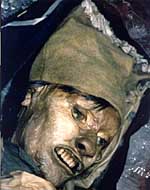
Credits
Home
Help
Comparing the true with the fictional
An anthropologist who examined the bodies of sailors lost in Franklin's Third Expedition compares his experience with the Arctica story.
Owen Beattie has been investigating the loss of the Third Franklin Expedition for over fifteen years. Reports of his team's findings were the inspiration for our fictional mystery.
Introduction
As a forensic anthropologist, my main work is to assist police agencies, coroners, and medical examiners in identifying the bodies of people who have died in our own time. However, I currently have students working on projects relating to Franklin's lost expedition, and I still have more than a few research articles to write on what we found.
Testing an Hypothesis
Part of our research involved performing autopsies on the frozen bodies of three crewmembers of Franklin's expedition. These men died in 1846, less than a year into the three-year expedition, and were buried on remote Beechey Island. Like the reasons for the loss of the expedition, it has always been a mystery why these three men died. We felt that, using modern forensic science, we could learn more about the events that led to the disaster by examining the bodies of these sailors. What we learned was totally unexpected.In science, when you approach a puzzle or a mystery to be solved, you develop an hypothesis based on what is already known, and then you test that hypothesis with an experiment or the collection of new evidence. For Franklin's expedition, the old interpretation (hypothesis) explained that it was scurvy and starvation that caused the disaster. What our research discovered was that the men were being poisoned by a relatively new invention: canned food. Lead in the solder (the material that seals the food tin) was contaminating the food and poisoning the men. In the Arctica mystery, I found it very interesting how the participants sifted through the evidence and developed new interpretations on what caused the deaths of the explorers. That's what we did, too!
The Doctor's Mistake
I feel that the way the explorers act in the Arctica mystery is likely very accurate. On the Franklin expedition, the doctors would be anxious to find out why men were sick and dying. But they did not yet have sufficient knowledge about lead and lead contamination to have suspected the tin food supply. The illnesses would have been a mystery. 
|
Frozen in Time:
|
When we were doing the autopsy on John Hartnell, a 25-year-old Able-Bodied Seaman from the Franklin expedition, we found that he had been autopsied already by the expedition's doctors. We were able to determine with modern tests that Hartnell was severely poisoned with lead, and almost certainly died as a result. However, the doctors in 1846 would have no way of knowing this. During our own autopsy we could see what the earlier doctors had done as they cut with their scalpel blades: after opening the body cavities of the chest and abdomen, they only examined the lungs and nothing else. Why? What they would have found in Hartnell's lungs is what we found: evidence of tuberculosis. Almost certainly they would have told themselves: "Hartnell died of tuberculosis. Case closed; no need to look further." We know today they were wrong.
This reminded me a lot of the actions of the young doctor in the Arctica mystery. He would have felt confident about diagnosing what was happening to the explorers, and would have been anxious to apply the most current medical theory of the time to make his patients well again. As you have read, this did not work for him either.
The Possibility of Disease
Another situation in the Arctica mystery brought back some interesting memories. As we planned our project, and discussed all of the possibilities that could arise while exhuming the bodies, we realized that we would have to accommodate an unpleasant possibility: the sailors may have died of a communicable disease. A virus, like smallpox, could have survived in the frozen ground, only to be revived by our actions. Therefore, part of our preparations was a plan for us to remain quaranteened on Beechey Island if our medical doctor observed any evidence of a communicable disease.Beechey Island is a perfect place for such a quaranteen, as it is small and very isolated. Our project was quite self-sufficient, and we could have remained there for however long would have been necessary for our doctor to determine whether we had become infected or not. My own feeling was that, because there were only three graves, with one of the men dying over three months after the first two, the likelihood of a major infectious disease was low. In the Arctica mystery, the situation was different, and it clearly reminded me of how researchers need to prepare for every possibility when exploring the unknown.
Connecting to the Past
Finally, I thought that having a living descendant of one of the Arctica explorers engage in a search for answers was very appropriate and thought-provoking. Much of our history is made real to us today because we have direct memories and connections to events in the past. These connections are through our ancestors. When we went to Beechey Island to expose the bodies of the three Franklin sailors, I had invited a descendant of one of the sailor's families to come with us. One day, as we melted the ice from around the body of John Hartnell, my friend came face to face with his great-great uncle. History is real.Owen Beattie
Department of Anthropology
University of Alberta
Edmonton, Alberta
Canada
An Access
Excellence Science Mystery sponsored by Genentech,
Inc.
Copyright © 1997 Genentech, Inc.; all rights reserved.
